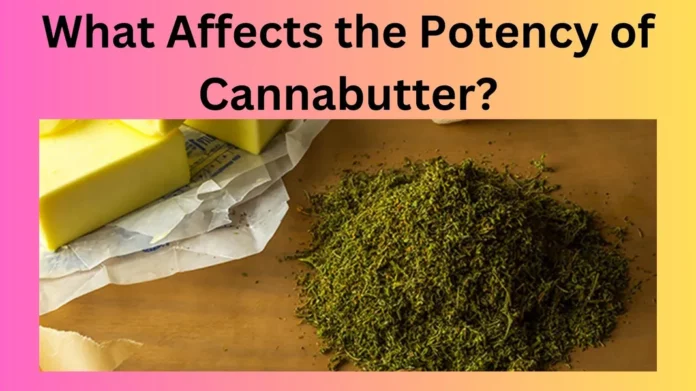Cannabutter, a staple in the world of cannabis-infused recipes, is renowned for its versatility and ability to turn ordinary dishes into delightful cannabis-infused creations. However, the potency of your cannabutter can vary significantly depending on several factors. In this article, we will explore the key elements that influence the potency of cannabutter, helping you achieve your desired effects in your culinary adventures.
Understanding Cannabutter
Before we delve into the factors affecting cannabutter potency, let’s first understand what cannabutter is. Cannabutter is a combination of butter and cannabis. It’s created by infusing butter with the active compounds found in cannabis, primarily THC (tetrahydrocannabinol) and CBD (cannabidiol). The potency of cannabutter is determined by the concentration of these compounds in the final product.
The Source of Cannabis
One of the most significant factors affecting the potency of cannabutter is the source of your cannabis. The strain, quality, and cannabinoid content of your chosen cannabis play a pivotal role in determining the final strength of your cannabutter. High-THC strains will result in more potent cannabutter, while CBD-dominant strains will create a milder effect.
Decarboxylation Process
Decarboxylation is the process of heating cannabis to activate its cannabinoids. Without this crucial step, your cannabutter will lack potency. To decarboxylate your cannabis, spread it evenly on a baking sheet and heat it in the oven at 240°F (115°C) for about 40-50 minutes. This transforms the inactive THCA and CBDA into the psychoactive THC and CBD.
Butter Quality
The type of butter you use can also affect the potency of your cannabutter. High-quality, unsalted butter is recommended, as it has a higher fat content that efficiently absorbs and retains cannabinoids. Opt for organic butter whenever possible.
Cannabutter Preparation Method
There are various methods to prepare cannabutter, including stovetop, slow cooker, and sous-vide techniques. Each method influences the potency of your end product. Some methods are more efficient at extracting cannabinoids from the cannabis, resulting in more potent cannabutter.
Cannabis-to-Butter Ratio
The ratio of cannabis to butter is another critical factor. Generally, a common guideline is using 1 ounce (28 grams) of cannabis for every 1 pound (450 grams) of butter. However, you can adjust this ratio to control the potency. Using more cannabis will yield stronger cannabutter.
Cooking Time and Temperature
The cooking time and temperature during the infusion process can impact potency. Cooking your mixture for too long or at too high a temperature can degrade the cannabinoids, leading to less potent cannabutter. A low and slow approach is often the best.
Straining and Filtering
Properly straining and filtering your cannabutter is essential to remove plant material. Neglecting this step can result in a gritty, less potent final product. Use a fine strainer or cheesecloth to ensure a smooth, potent cannabutter.
Storage Conditions
How you store your cannabutter also affects its potency. Keep it in an airtight container in a cool, dark place. Exposure to heat, light, and oxygen can cause the cannabinoids to degrade over time, reducing its strength.
Individual Tolerance
The effects of cannabutter can vary significantly from person to person due to individual tolerance levels. What might be a mild dose for one person could be a potent experience for another. Start with a small amount and gradually increase your dosage to find your comfort zone.
Conclusion
The potency of your cannabutter is influenced by a variety of factors, from the quality of your cannabis to the cooking method and storage conditions. By understanding and controlling these elements, you can create cannabutter that perfectly suits your culinary and recreational needs.
FAQs
1. Can I use any strain of cannabis to make cannabutter?
- While you can use any strain, the potency and effects of your cannabutter will vary based on the strain’s cannabinoid profile. High-THC strains are commonly used for potent cannabutter, while high-CBD strains yield a milder effect.
2. Is it essential to decarboxylate cannabis before making cannabutter?
- Yes, decarboxylation is a crucial step to activate the cannabinoids in cannabis. Without it, your cannabutter will lack potency.
3. How long does cannabutter remain potent in storage?
- When stored properly in an airtight container in a cool, dark place, cannabutter can remain potent for several months.
4. Can I adjust the potency of my cannabutter after it’s made?
- Yes, you can adjust the potency by adding more or less cannabutter to your recipes, depending on your desired effects.
5. What’s the recommended dosage for first-time cannabutter users?
- For beginners, it’s advisable to start with a small dose, typically 5-10mg of THC, and gradually increase as needed to avoid overconsumption.
Remember, creating the perfect cannabutter for your needs requires some experimentation and fine-tuning. By considering these factors, you can tailor your cannabutter to your desired potency, whether it’s for medicinal or recreational use. Enjoy your culinary adventures with cannabis-infused recipes!















